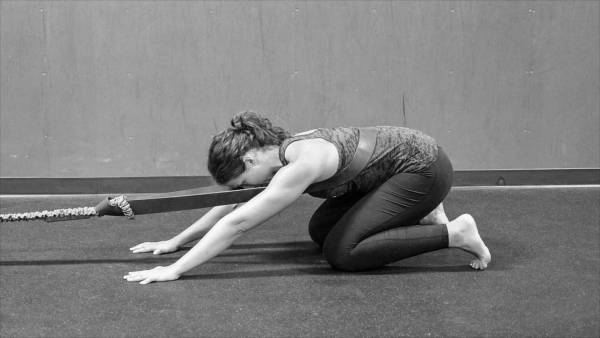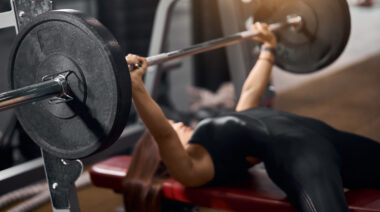Want an easy way to increase core stabilization in the central zone and decrease fascial tension in your back at the same time? Say yes.
Resisted quadruped rock (RQR) is the answer. A simple and effective way to release tightness in the thoracolumbar fascia while simultaneously engaging the abdominal stabilizing muscles. To put it simply, you become a powerhouse in your core.
First Let’s Talk About the TLF
The TLF area is extremely important for the biomechanics of movement because of its unique ability to shift loads and transfer forces from the lower extremities to the upper extremities. This is critical to understand if you want to optimize efficient movement patterning and unleash power.
The TLF helps the body shift loads and transfer forces. For example, posterior oblique swing movements between the upper and lower extremity (as indicated by the grey arrows) allow for throwing movements.
The thoracolumbar fascia has three layers attaching to many other core stabilizing structures:
- Anterior layer – Attaching to the anterior aspect of the lumbar transverse processes and the anterior surface of the quadratus lumborum.
- Middle layer – Attaching to the medial tip of the transverse processes, as well as external and internal oblique, and giving rise to the transverse abdominis (TrA) muscle applying 95% of passive tension to the TrA aponeurosis.
- Posterior layer – Covering all of the muscles from the lumbosacral region through the thoracic region, as far up as the cervical splenii attachments (basically from your lower back up to the base of your neck). This posterior layer attaches to both the erector spinae and gluteus maximus aponeurosis. The gluteus maximus and contralateral latissimus dorsi attach with each other and coordinate, allowing crosslink movements between the upper and lower extremity, which makes walking and running possible. This crosslink is known as the posterior oblique sling.
Quadruped position gives four points of stabilization reducing threat of instability to the nervous system. Rocking against resistance reflexively activates the abdominal bracing mechanism. The central axis cylinder of support is engaged from 360 degrees. You are are also getting engagement of the posterior oblique subsystem, glute max, and latissimus muscles.
How to Perform the RQR

Rocking against resistance reflexively activates the abdominal bracing mechanism.
- Use a 1.5 inch or 2 inch resistance band for optimal width and tension.
- Wrap the band around your waist and bring it up to the thoracolumbar junction T12/L1 – the bottom of the ribcage. It’s best if the band is on your skin to prevent sliding on clothing. This will also shear the fascia more effectively.
- Anchor the band low to the ground. This helps with the downward and forward pull of the band and prevents slipping.
- While in quadruped position, move back from the anchor point to establish tension.
- Your hands go below the shoulders and knees go below the hips.
- Now widen your hips for a more stable base by widening the knees.
- Bend your ankles so you are in a dorsiflexed position with toes extended.
- Keep your head in a neutral position. Do not extend or flex the neck.
- Rock backward by pushing away with your hands and sitting back into the ankles.
- Do not round your back. The band will help prevent rounding.
- Hold for 4 seconds and maintain normal breathing. If you cannot maintain normal breathing, either move closer to the anchor point to reduce tension or get a lighter band. Loss of breath control indicates the load is too high.
- Eccentrically control the return to starting position and repeat the pattern holding each concentric repetition for 4 seconds.
- Do a total of 10-12 repetitions.
Perform at the beginning of any workout program.
Start With Mobility
Can you see which movement pattern the RQR looks like? The overhead squat. After doing RQR, you may discover that your overall squat pattern improves and strength increases.
One reason people cannot get into a standing overhead squat position is lack of stabilization. The nervous system prevents movement because it senses poor stability. Stability always limits performance and must always precede force production. As Paul Chek said, “You can’t fire a cannon from a canoe.”
“The TLF area is extremely important for the biomechanics of movement because of its unique ability to shift loads and transfer forces from the lower extremities to the upper extremities.”
Mobility restrictions also impact the pattern. If you discover poor mobility anywhere in the body – particularly in the ankle, hip, wrist, and thoracic spine – then, release the restrictions first and follow with the resisted quadruped rock.
Get mobility and then teach the nervous system what to do with it – stability. Now go be a badass.
More Like This:
- Take Your Strength to the Next Level With Ipsilateral Crawling
- Lower Extremity Pain? Check Your Lateral Sub-System
- Climb Your Way Up and Heal Your Neglected Shoulders
- New on Pulse Beat Fit Today
References:
1. Baniel, Anat. Move into Life: The Nine Essentials for Lifelong Vitality. New York: Harmony, 2009. Print.
2. Chek, Paul. Movement That Matters: A Practical Approach to Developing Optimal Functional Movement Skills. Encinitas, CA: C.H.E.K. Institute, 2000. Print.
3. Cook, Gray. Movement: Functional Movement Systems: Screening, Assessment, and Corrective Strategies. Aptos, CA: On Target Publications, 2010. Print.
4. Schleip, Robert. Fascia: The Tensional Network of the Human Body: The Science and Clinical Applications in Manual and Movement Therapy. Edinburgh: Churchill Livingstone/Elsevier, 2012. Print.
5. Vleeming, Andry. Movement, Stability, and Low Back Pain: The Essential Role of the Pelvis. New York: Churchill Livingstone, 1997. Print.ASER






